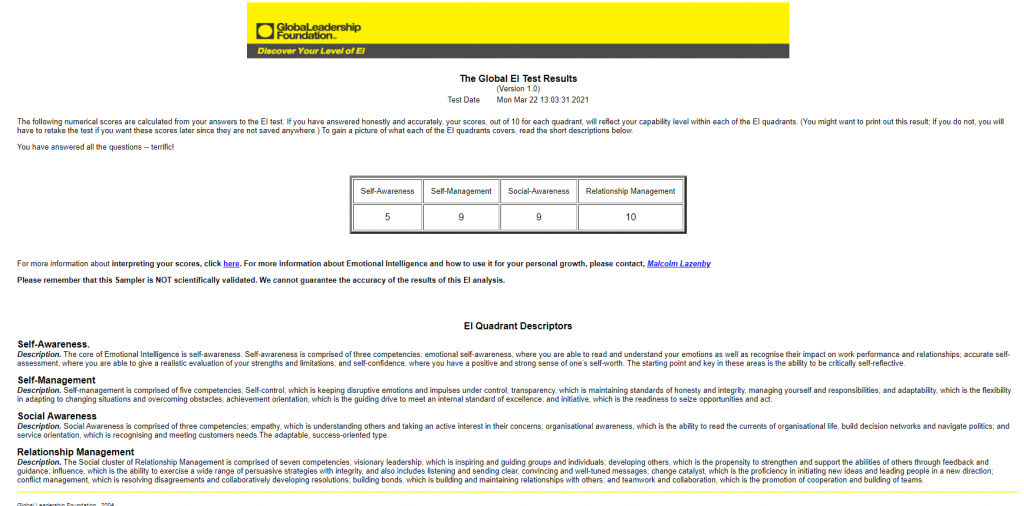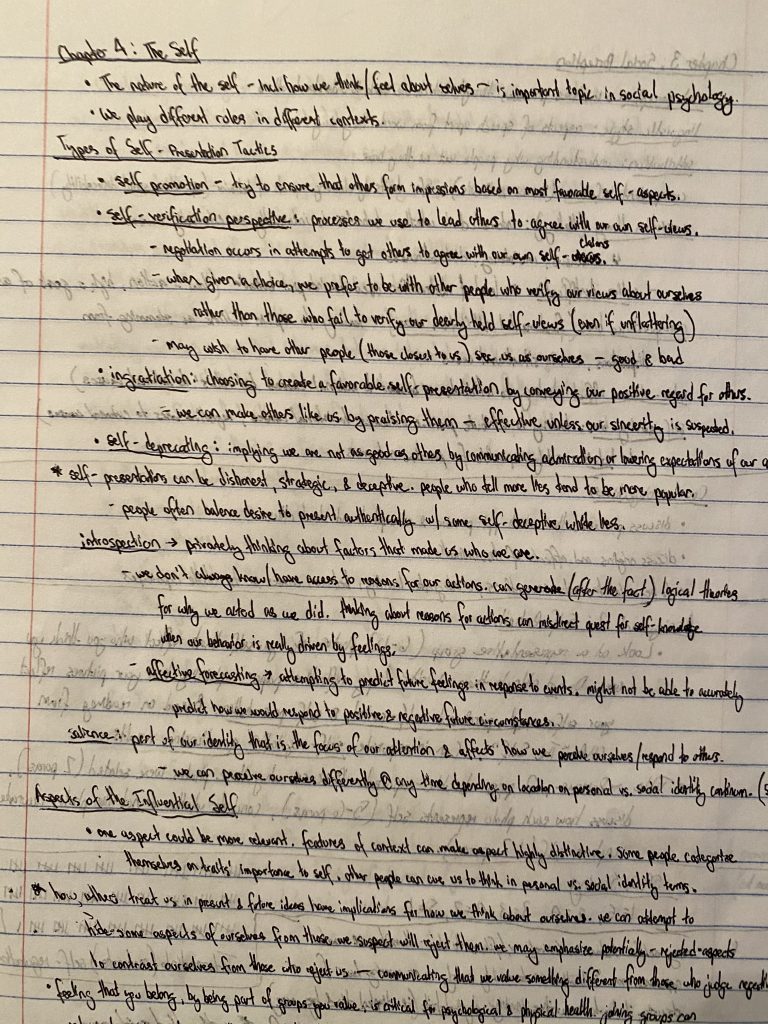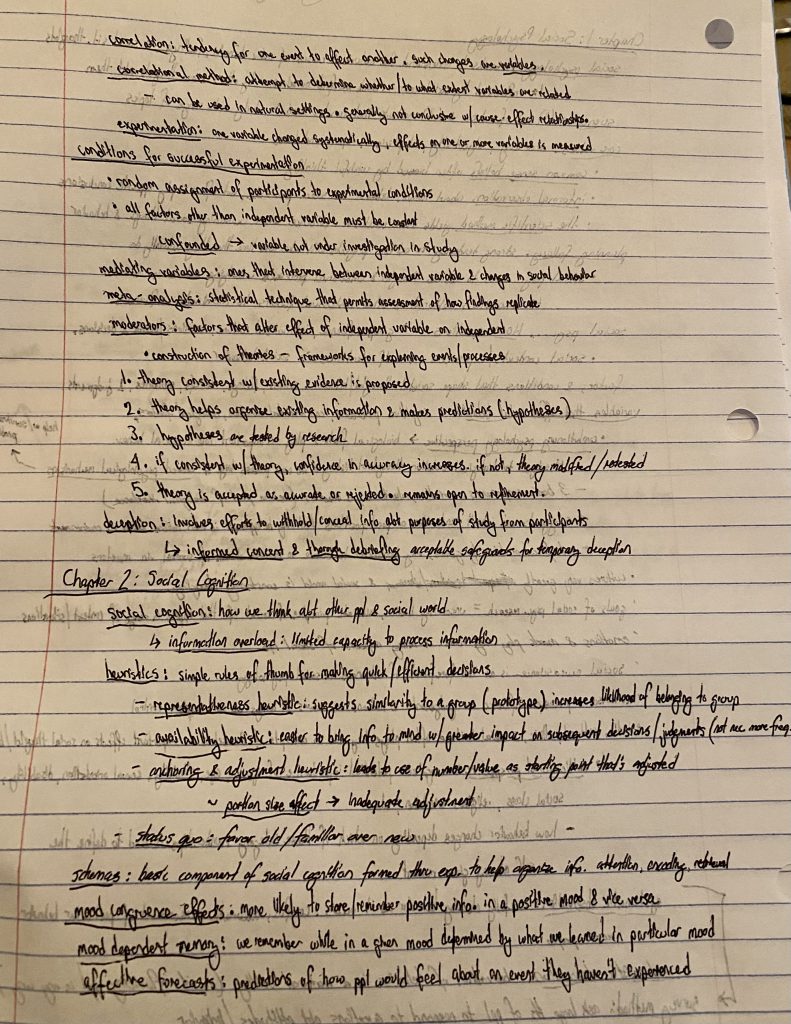Blog 10
In my first blog entry, I outlined three course expectations that resonated strongly with me. Now that we’ve reached the end of the course, I can confidently say that I feel as if I have achieved those objectives through the course material, as well as through the assignments (particularly the more interactive assignments, such as Assignment 5!). I approached the course hoping to gain a perspective in how individuals interact in different aspects of the world – in other words, a perspective into the facets of interpersonal connections – and this attitude was not only sustained, but achieved.
If I had the opportunity to take the course again, I would break my time spent working into bite-sized portions instead of tackling my workload for each week in one sitting. While this was a doable method for me (especially with a busy schedule outside of my studies), I feel as if my stress levels would have been more even had I set out small increments of time to work rather than one large chunk. Over the past few months, I’ve grown academically in a way I never thought I’d be capable of: I have become an organized student, who keeps a planner with assignments and due dates tracked beyond the first couple of weeks. I have never been the type of individual to maintain strict organization, yet I finally mastered the creation of that habit!
One skill I have gained from this course that I feel will benefit me in both professional and informal settings throughout my life would be interpersonal skills. This course has supplied a deeper understanding to the motives, consequences, and successes of the connections between individuals – namely, I have received information that will allow me to conduct myself in a way that positively impacts those I work with, as well as those I will cross paths with every day. This skill, I believe, is one of the most invaluable an individual can possess: who are we, as humans, without those connections which define us and our hearts?
For my visual representation, I’ve included a comic strip that illustrates my organization skills prior to taking this course! Now that I have grown as a student, I can proudly say that my days of being unable to locate my planners (or not owning a planner at all!) are safely behind me.

Blog 9
There have been many concepts in this course, specifically included within my e-Portfolio, which have been significant to my overall take-away.
Notably, Blog 8 and Blog 7 contained important lessons in interpersonal relationships and emotional maturity. Improving and maintaining my connections with others is a goal I aim to work actively toward each day. Being able to consider the perspectives of others who are different from me and well as the influences that contribute toward those perspectives in one step in a positive direction.
That lesson is reflected in Assignment Takeaway 4, in which we studied different styles of love. By understanding my own style of love and that of my future partner, our relationship can be improved by prioritizing a consideration of our respective styles. Again and again, the importance of interpersonal relationships and the influences that might impact (both positively and negatively) how we interact with one another resurfaces in the course material.
Finally, the way that women are stereotyped and negatively impacted by society and/or by the opposite sex offered a great deal of insight and revelation into my own experiences and my relationship with everyday media! Watching advertisements and seeing representation in films, I find myself hyperaware of the way women are unrealistically depicted. I hope that my generation will become more self-aware of the negative consequences that come with these unrealistic standards and portrayals.
/glass-saucepan-on-a-gas-burner-with-boiling-water-dor961844-57fba8b03df78c690f79f7c6.jpg)
Blog 8
In the article “Sexual Conflict: Uncovering the Mysteries of the Mating Battleground”, C. Nathan DeWall draws the role of evolutionary psychology in sexual (heterosexual, specifically) conflict. It was a surprise to me to read that about 70% of the surveyed men were found to have feigned emotional interest for a sexual end-goal. The biological factors at work in the reproductive process (quantity over quality, for men) certainly serve as a strong basis for the evolutionary argument, though I have to wonder if our society and its stereotypes or norms contribute to a lesser or greater degree than our hind-brain genetics.
Based on conversations with my peers and with my own experiences, there are several ways in which men upset women and vice versa. Men tend to view women as overemotional, leading to explosive arguments and feelings of dismissal. Women, especially if they have learned from experience, are often concerned with the fidelity of their partners, which can make men feel untrusted and that their relationship is unbalanced.

Blog 7
Self-regulation is one of many facets that encompass the concept of emotional intelligence. Having a high level of emotional intelligence indicates that an individual will have the abilities and skills to self-regulate successfully and vice versa: that the ability to successfully self-regulate implies one area of success in the realm of emotional intelligence.
To me, emotional intelligence is best defined as the trait by which we manage healthy and successful relationships not only with those around us, but with ourselves as well. Healthy communication skills, empathy, consideration, honest self-analysis, and emotional regulation are all pieces of what I view as the broader spectrum of emotional intelligence.
When there are disagreements between myself and other family members (or between family members in need of a mediator), I utilize skills of emotional intelligence to view the full perspective of the situation (rather than simply my own) and to find a resolution that ensures that everyone involved feels heard and loved – even despite the disagreement at hand. In reference specifically to the self-regulation discussed in the video, I have suffered from panic attacks/episodes during my adolescent and adult years and have learned how to implement techniques such as breathing practices and self-guided meditation (such as the “body scans” referenced therein) to regain control of my emotional response and return to a present and alert state of mind.

Blog 6
After watching Jean Kilbourne’s presentation, I found myself incredibly moved by the decades of examples in the objectification of women in ads and the media. This is a topic that I learned as early as middle school thanks to the teachers I was lucky enough to have who were not required to inform their students of these harmful stereotypes, yet still felt obligated to do so. While I was aware that men are also distorted by ads, this video helped illustrate the differences in those distortions: that their stereotypes are less body-oriented and that they are not inherently required to live in a world defined by the danger of sexual violence.
Pictured below are five ads I selected to serve as a visual representation of the claims illuminated in the video:

This example clearly illustrates the objectification of women, comparing someone scandalously-dressed to butchers’ cuts of livestock. PETA is “selling” the ideal of vegetarianism/veganism through the sexualization of women.

This ad claims to appeal to a diverse range of body types for women, yet displays only one: dangerously thin and “perfectly” hourglass. This perpetuates the harmful effect ads such as these have on the self-esteem of women.

Why does KRAFT need a sensually-suggestive ad to sell mac & cheese? The utilization of sex in ads such as these is one common theme throughout the presentation, especially when it has nothing to do with the original product!

Women are forced to live in a world in which sexual violence is a very real, unsettlingly common danger. We cannot walk the streets unaccompanied, we can’t walk through parking garages at night, and we can’t leave drinks unattended at parties. To see this trivialized in an ad is sickening.

Similarly to the KRAFT ad, ChapStick uses the objectification of women and the trivialization of sex in order to sell their product. Intended for application to the lips, you can’t even see the young woman’s face in the image!
Blog 4
Of the handful of questions that I missed on Exam 1, the concepts covered were the following: groups, self-insight, cognition, overconfidence barrier, and deception. These are topics from the notes that I will be reviewing more carefully; in the future, I will space my time taking notes over several days rather than cramming one full chapter into the space of a few hours, as I’ve been apt to do. I believe that by taking this approach to better preparing prior to an exam, I’ll be able to improve my score from a B-grade to an A-grade score on the next exam.
For my visual representation, I’ve included an example of my notes from Chapter 4, as seen below:

Blog 3
After reading the findings of “Soul Meets Body“, I was surprised to discover that the similarities in music taste between myself and my loved ones have typically been less frequent than dissimilarities. While we sometimes share one or two favorite songs or artists in common, our preferences in a genre as a whole are usually nothing alike! For example, while I prefer mostly indie or folk-adjacent music, my friends favor genres such as show-tunes, heavy metal, pop, and rap. Despite these differences, our values and ideals are highly similar!
Two songs I associate with my longtime friend are “Honeybee” by Steam Powered Giraffe and “The Phantom of the Opera” from the Broadway production of The Phantom of the Opera. The former choice is due to a vivid memory I recall from the first time she showed me the song (by physically placing the headphones over my stubborn ears) and inspiring a solid love for it. The second song is connected to the shared interest that began our friendship back in middle school when our chorus instructor introduced our class to the 2004 film; we still share a love of the story to this day. My third song would be “Some Things Never Change” from the Frozen II soundtrack, associated with an Australian friend who shares an adoration of the films with me. For the fourth, “Final Girl” by Graveyardguy and Slayyyter is credited to a friend who is equally as passionate about the intricacies of horror films as I am. The fifth song, “King of Anything” by Sara Bareilles, is representative of my friendship with a friend who acted as an anchor through one of the worst experiences of my life; creating a playlist for me with this song among the others was only one of many acts of support. The sixth and final song, “Leave Her, Johnny” is an old sea shanty that my twin sibling and I have spent quite a bit of time singing loudly together and brings with it many fond memories!

Blog 2
When it comes to my academics, I made every effort I could in order to excel through my time from kindergarten to graduating from high school. Once I transitioned into college, I found myself struggling with my self-concept as a student: subjects and material had come so effortlessly to me in my youth; the actual challenges presented by college caused me to doubt my own abilities.
Since my freshman year back in 2018, I’ve learned that I am a good student when I put forth the dedication and effort required of us all. I pulled myself from a position of defeat and worked harder than I have in some time: my hard work was rewarded last semester by an associate degree in social sciences from Tidewater Community College. Now I attend Old Dominion University in the pursuit of a bachelor’s degree and I’ve maintained the work ethics I developed in order to learn from the failures of my past.
In my dedication to improving my self-confidence in my studies, I’ve developed better studying habits and take proactive measures in managing my time and ensuring I keep a tidy schedule of all upcoming assignments. Even so, I still have ways in which I can improve: while I’m writing this blog entry at 9:00 pm on the due date rather than not completing the assignment at all, the elimination of my tendency to procrastinate would certainly increase my confidence!
After taking the General Self-Efficacy Scale, I received a mean result of 3.5/4, which signifies that I possess a higher perceived general self-efficacy. With the knowledge of the active work I’ve put into improving my efficacy as a student and in the accomplishments I’ve achieved as a result of my success, I believe this result has been hard-earned. I evidently still have room in which to grow and further improve my role as a student, though I am confident that I will find a path that fits me best and lifts me toward my goals.

I selected the above image of my high school graduation to illustrate my accomplishments as a student (indicative of both my diploma and my honor cords). Can you believe that, once upon a time, we had stadiums stacked with student families for events like graduations?
Blog 1
Among the course objectives outlined in the syllabus, there are three points that stood out prominently to me. These points are not only lessons that will be helpful to me in the future, but expectations I expect to fulfill from the course.
First, I anticipate that learning how to discuss the processes through which people perceive and attempt to understand others will be a skill vital to succeeding in adult life. Understanding others and maturing one’s sense of empathy offers an ability to create and maintain social relationships in every aspect of daily processes (work, home, etc.).
Secondly, knowledge concerning the origins and affects of discrimination is necessary in being able to comprehend the inherent social privileges one might possess compared to the unfair and prejudiced experiences others are forced to endure.
Finally, the ability to make connections, or integrate learning, between courses and to outside experiences is a requirement when exploring the field of psychology (my intended major). In order to progress through my education of this broad field, the branches that support it – including social psychology – will improve a well-rounded experience in the study.
I expect to gain a greater understanding of myself and those around me by succeeding in this course and in mastering these – as well as all other – concepts in the coursework. In order to ensure this success, I will keep a close schedule of assignments and will thoroughly explore the assigned material each week.

This image was selected as my representative visual because it illustrates the habit I will be adhering to by taking diligent notes for each chapter of the assigned reading.